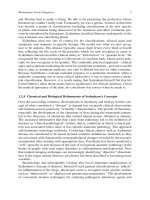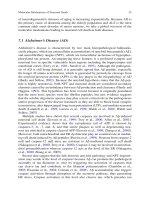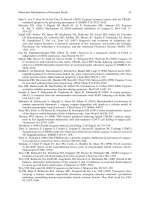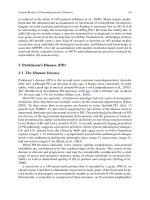Neurochemical Mechanisms in Disease P1 ppsx
Bạn đang xem bản rút gọn của tài liệu. Xem và tải ngay bản đầy đủ của tài liệu tại đây (480.53 KB, 10 trang )
Advances in Neurobiology
Volume 1
Series Editor
Abel Lajtha
For further volumes, go to
/>
John P. Blass
Editor
Neurochemical Mechanisms
in Disease
1 3
Editor
John P. Blass
Weil Medical College of Cornell
University
White Plains, NY 10605, USA
ISSN 2190-5215 e-ISSN 2190-5223
ISBN 978-1-4419-7103-6 e-ISBN 978-1-4419-7104-3
DOI 10.1007/978-1-4419-7104-3
Springer New York Dordrecht Heidelberg London
© Springer Science+Business Media, LLC 2011
All rights reserved. This work may not be translated or copied in whole or in part without the written
permission of the publisher (Springer Science+Business Media, LLC, 233 Spring Street, New York,
NY 10013, USA), except for brief excerpts in connection with reviews or scholarly analysis. Use in
connection with any form of information storage and retrieval, electronic adaptation, computer software,
or by similar or dissimilar methodology now known or hereafter developed is forbidden.
The use in this publication of trade names, trademarks, service marks, and similar terms, even if they are
not identified as such, is not to be taken as an expression of opinion as to whether or not they are subject
to proprietary rights.
While the advice and information in this book are believed to be true and accurate at the date of going
to press, neither the authors nor the editors nor the publisher can accept any legal responsibility for
any errors or omissions that may be made. The publisher makes no warranty, express or implied, with
respect to the material contained herein.
Printed on acid-free paper
Springer is part of Springer Science+Business Media (www.springer.com)
Preface
This volume of Advances in Neurobiology deals with the neurochemistry of disease.
Included are chapters on both human diseases and animal “model” diseases.
Sources of human tissue.
The three main sources of human neural tissues for chemical studies have been:
Brain obtained at autopsy
Brain obtained at biopsy or incidental to neurosurgery
Nonneural tissues containing molecules identical to those in clinically affected
brain or nerve
In theory, peripheral nerve is more available than brain, but chemical analyses of
peripheral nerves are relatively limited.
A major problem in doing chemistry on brain obtained at autopsy is the possibil-
ity of artifacts arising during the process of dying or in the interval between death
and chemical analysis: agonal or postmortem artifacts. During the first decades
of modern neurochemistry, this problem was considered so severe that few stud-
ies were done on autopsy material. Over 30 years ago, Davison and Bowen and
their coworkers at Queen Square in London recognized that it was possible to study
meaningfully in autopsy brain those molecules that were stable agonally and post-
mortem (Bowen et al., 1976). Their r ecognition that one of these proteins was the
enzyme choline acetyltransferase allowed them to make major discoveries about the
vulnerability of the cholinergic system in Alzheimer disease; that discovery has led
to the only available treatments for this common and devastating condition.
Davison and coworkers did extensive control experiments to ensure that they
were studying properties of the brain rather than artifacts that arose during the pro-
cess of dying or after death. Unfortunately subsequent workers have not always
adhered to those meticulous standards. It is relatively easy to obtain pieces of human
autopsy brain in a hospital or medical school from people who had a variety of
diseases of the brain as well as from “controls” free of brain disease detected clin-
ically during life. These are, of course, not truly “healthy controls.” They are, after
all, dead; they have to have died of something. The ease with which samples of
human brain can be obtained has, unfortunately, allowed publication of studies
v
vi Preface
where control of sample quality has been sloppy. Interpretation of neurochemical
data obtained from autopsy brain must always take into account the possibility of
the agonal or postmortem artifacts that so worried earlier neurochemists.
Chemical measurements have also been made on human brain tissue obtained
from biopsies or from therapeutic surgery (Smith et al., 1983). Here, agonal and
postmortem artifacts are not a problem. However, the tissue available is limited.
Patient welfare rather than scientific utility must determine the amounts of tissue
available and the anatomical sites from which it comes.
An experimental approach that avoids concerns about the quality of brain tissue
is to study in available peripheral tissues genes or gene products that are identical
to those in neural tissues. Examples include blood cells and cultured skin fibrob-
lasts, and to a lesser extent biopsies of other tissues such as muscle (Bubber et al.,
2005). Most workers assume that genes are identical in all tissues examined from
an individual but worry about epigenetic modifications, to DNA as well as to post-
translational and posttranscriptional products. However, extensive data indicate that
study of proteins in peripheral tissues can often give critical information about those
molecules in the brain: the standard A striking example is the use of white blood
cells and cultured skin fibroblasts to elucidate enzyme defects in inborn errors of
metabolism. A well-known example is Tay–Sachs disease (GM
2
–gangliosidosis)
(Roe and Shur, 2007).
Animal tissues.
Brain and other tissue from sick experimental animals is as readily available as from
healthy animals. That includes transgenic and other animals with “model human
diseases.” But, it is vital to remember that mice are not men, nor are rats or other
experimental animals. For instance, triple transgenic mice have been crafted that
develop light microscopic lesions that mimic those of Alzheimer disease (AD).
(Pietropaolo et al., 2009). However, direct molecular studies document that such
triple gene mutations are not the cause of human AD (Tanzi et al., 1991). Treatments
have been identified that benefit “Alzheimer mice” (Sung et al., 2004) but not human
patients with this illness. (Petersen et al., 2005; Tabet et al., 2000)
Disease.
Neurochemical studies of illness of the brain typically involve comparing a set of
samples classified as “disease” versus a set of samples labeled “control.” Clinicians
or pathologists do the classification, not chemists. At the extremes of health or ill-
ness, it may seem easy to decide who is sick and who is not. In fact, the line is hard
to draw. If bizarre and often self-destructive behavior is a sign of mental illness, do
we classify adolescence as a form of madness? Are intestinal parasites found in the
majority of people in a population “normal” or a form of disease? We have been
treating hookworm even though this “germ of laziness” was once endemic in the
states of the old Confederacy. Social consensus is particularly important in labeling
as “sick” behaviors that are odd but not harmful. Certain sexual variants are consid-
ered worth treating in the United States but are thought of as harmless eccentricities
in England. (That shocked some of my fellow Americans who went for additional
Preface vii
training in psychiatry at the Maudsley Hospital in London.) Soldiers who sacrifice
their lives intentionally for their comrades are not classified as suicidally insane.
Instead we give them medals.
Specific diseases.
For the last three centuries, it has been conventional to classify sick people as hav-
ing one or another specific disease. That includes illness of the nervous system,
psychiatric as well as neurological. In fact, the concept of specific diseases is a use-
ful but fundamentally unrealistic abstraction. It is one of those approximations that
comes out of the English Enlightenment, that are too useful to be discarded even
though they do not stand up to close analysis. Grouping patients according to their
“disease” helps to provide guidelines for their care, even though in fact every sick
person is different from every other sick person. Skilled care requires individualiza-
tion of care. The British psychiatrist R. E. Kendall has developed the logic of this
conundrum with great clarity (Kendall, 1975).
An historical aside may clarify the issues. In the medical tradition that went
from the ancients ( Hippocrates and Galen) through the Middle Ages until the
Enlightenment, physicians basically thought about disease in terms of mechanism.
The conventional “theory of humors” was a crude attempt to describe illness in
terms of imbalances in body composition, before the invention of modern chemistry
and biochemistry.
The modern theory of “specific diseases” was developed in the 1600 s by an
English physician, Thomas Sydenham (Haas, 1996). His Latin was too weak for
him to study the medical literature of his time, but the professoriat at Oxford granted
him a medical degree anyway: his brother was one of Oliver Cromwell’s colonels.
Came the Restoration, and Sydenham had to make a living. Fortunately, he was a
genius. He recognized that specific patterns of signs and symptoms could define
clinical entities that typically responded to specific medications. His model was the
use of quinine to treat malaria, to treat “tertian and quartan fevers.” His concept of
specific diseases responding to specific medicines was so powerful that it has come
to dominate medicine.
In the later nineteenth and early twentieth century, German-speaking neuropsy-
chiatrists (“alienists”) defined neuropsychiatric diseases for which they could not
find a neuropathological substratum in terms of the aberrant behaviors. Although
sensible enough for the state of knowledge at that time, this approach has been
breaking down in recent decades. It is now clear that the same gene mutation
can lead to different psychiatric syndromes, to different “diseases” as they are
now defined. One classic example is the gene DISC 1, which can predispose to
“schizophrenia” as well as to “bipolar disease” (manic-depressive psychosis) and
“depression” (Chubb et al., 2008).
Perhaps more important, behavioral patterns alone do not predict response to
chemicals that act on the nervous system, that is, to medications (Blass, 2006). Thus,
behavioral manifestations do not identify specific diseases in the sense originally
defined by Sydenham. That is true even of the detailed behavioral classifications
created by the committees that write the Diagnostic and Statistical Manual of
viii Preface
the American Psychiatric Association (the successive versions of DSM) (American
Psychiatric Association, 2000).
Neurobiology and specifically neurochemistry may—one hopes—give rise to
more biologically based and therefore presumably more clinically useful defini-
tions. The editors hope that this volume on the neurochemistry of disease will further
that aim.
White Plains, NY John P. Blass
References
American Psychiatric Association (2000) Diagnostic and Statistical Manual of Mental Disorders
DSM-IV-TR Fourth Edition (Text Revision). American Psychiatric Association, New york, NY
Blass JP (2006) Concise clinical pharmacology: CNS therapeutics. McGraw-Hill, New york, NY
Bowen DM, Smith CB, White P, Davison AN (1976) Neurotransmitter-related enzymes and indices
of hypoxia in senile dementia and other abiotrophies. Brain 99:459–496
Bubber P, Haroutunian V, Fisch G, Blass JP, Gibson GE (2005) Mitochondrial abnormalities in
Alzheimer brain: mechanistic implications. Ann Neurol 57:695–703
Chubb JE, Bradshaw NJ, Soares DC, Porteous DJ, Millar JK (2008) The DISC locus in psychiatric
illness. Mol Psychiatry 13:36–64
Haas LF (1996) Thomas Sydenham (1624–89). J Neurol Neurosurg Psychiatry 61:465
Kendall RE (1975) The role of diagnosis in psychiatry. Blackwell Scientific Publication, Oxford,
Philadelphia, PA (distributed by J. B. Lippincott)
Petersen RC, Thomas RG, Grundman M, Bennett D, Doody R, Ferris S, Galasko D, Jin S,
Kaye J, Levey A, Pfeiffer E, Sano M, van Dyck CH, Thal LJ (2005 Jun 9) Alzheimer’s
Disease Cooperative Study Group. Vitamin E and donepezil for the treatment of mild cognitive
impairment. N Engl J Med 352(23):2379–2388
Pietropaolo S, Sun Y, Li R, Brana C, Feldon J, Yee BK (2009) Limited impact of social isolation
on Alzheimer-like symptoms in a triple transgenic mouse model. Behav Neurosci 123:181–195
Roe AM, Shur N (2007) From new screens to discovered genes: the successful past and promising
present of single gene disorders. Am J Med Genet C Semin Med Genet 145C:77–86
Smith CC, Bowen DM, Sims NR, Neary D, Davison AN (1983) Amino acid release from biopsy
samples of temporal neocortex from patients with Alzheimer’s disease. Brain Res 264:138–141
Sung S, Yao Y, Uryu K, Yang H, Lee VM, Trojanowski JQ, Praticò D (2004) Early vitamin E
supplementation in young but not aged mice reduces Abeta levels and amyloid deposition in a
transgenic model of Alzheimer’s disease. FASEB J 18:323–325
Tabet N, Birks J, Grimley Evans J (2000) Vitamin E for Alzheimer’s disease. Cochrane Database
Syst Rev(4):CD002854
Tanzi RE, George-Hyslop PS, Gusella JF (1991) Molecular genetics of Alzheimer disease amyloid.
J Biol Chem 266:20579–20582
Contents
Mechanisms Versus Diagnoses 1
John P. Blass
Molecular Mechanisms of Neuronal Death 17
Elena M. Ribe, Lianna Heidt, Nike Beaubier, and Carol M. Troy
Animal Models of Neurodegenerative Diseases 49
Imad Ghorayeb, Guylène Page, Afsaneh Gaillard,
and Mohamed Jaber
Vitamins Deficiencies and Brain Function 103
Chantal Bémeur, Jane A. Montgomery, and Roger F. Butterworth
Brain Edema in Neurological Diseases 125
Eduardo Candelario-Jalil, Saeid Taheri, and Gary A. Rosenberg
Monoamine Transporter Pathologies 169
Natalie R. Sealover and Eric L. Barker
Glutamate and Glutamine in Brain Disorders 195
Lasse K. Bak, Arne Schousboe, and Helle S. Waagepetersen
Rho-Linked Mental Retardation Genes 213
Nael Nadif Kasri and Linda Van Aelst
Cognitive Deficits in Neurodegenerative Disorders: Parkinson’s
Disease and Alzheimer’s Disease 243
Ivan Bodis-Wollner and Herman Moreno
NF-κB in Brain Diseases 293
Cheng-Xin Gong
Trinucleotide-Expansion Diseases 319
Arthur J. L. Cooper and John P. Blass
CNS Cytokines 359
Jane Kasten-Jolly and David A. Lawrence
ix









